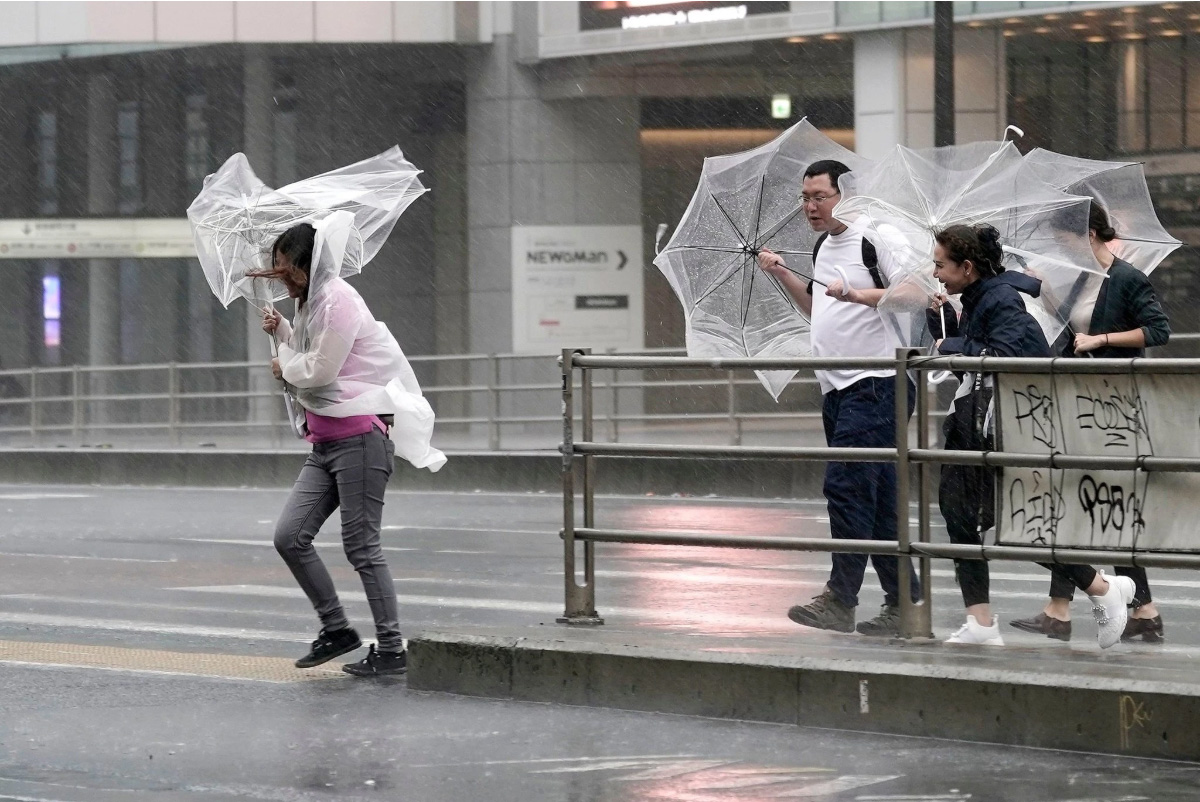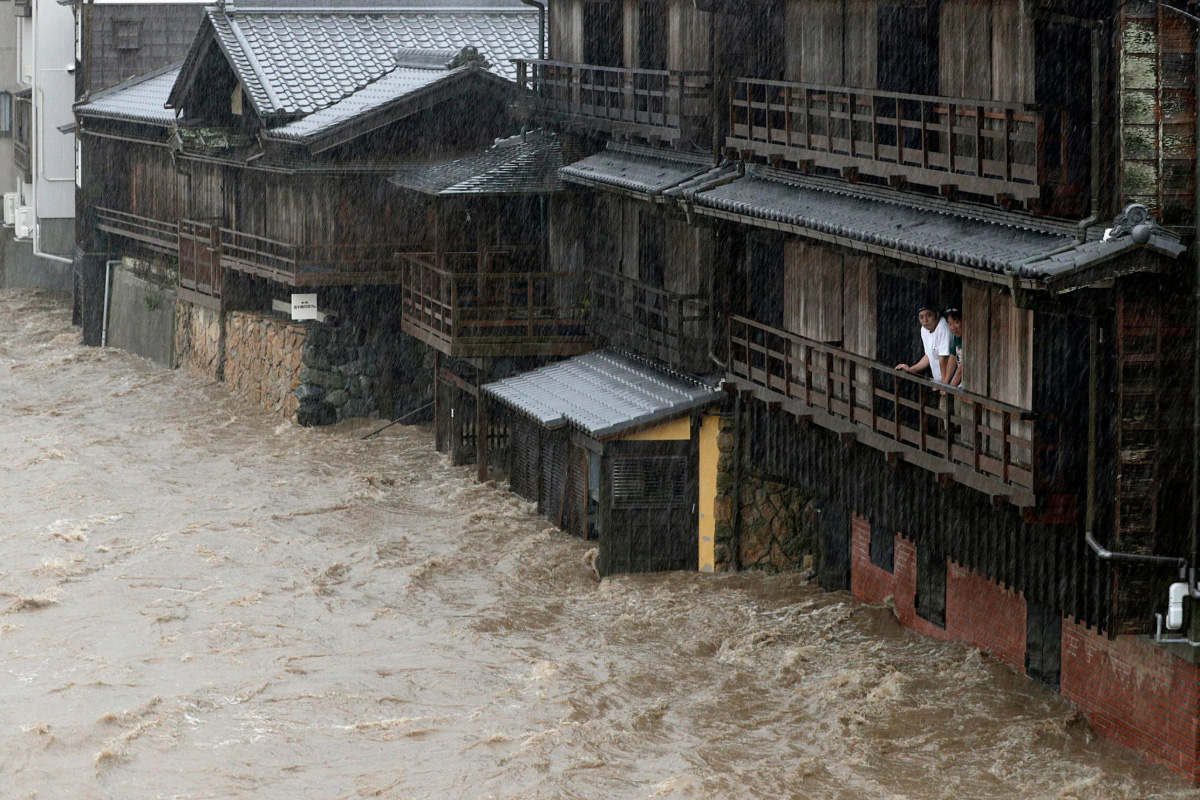TOKYO — Typhoon Hagibis, Japan’s largest storm in decades, lashed the country’s northeast early Sunday morning, just hours after hitting the Tokyo region with heavy rain and high winds that forced many residents to move to evacuation centers.
Record rains flooded rivers, pushed dams to their limits and caused several landslides. An earthquake measuring 5.7 magnitude also shook Chiba, east of Tokyo, early Saturday evening.
One death was reported in a cyclone in Chiba, and NHK, the public broadcaster, reported that another person died after a landslide crushed his home in Tomioka City in Gunma Prefecture, northwest of Tokyo. Thirteen other people were missing, NHK said. Landslides were also reported in Sagamihara, a suburb of the city, and in Shizuoka, a coastal city to the southwest.
The storm made landfall around 7 p.m. on Saturday in Ito, a resort town on the Izu Peninsula, also southwest of Tokyo.
By midnight, the rain and wind had moved past the capital, leaving some flooding in the city’s west.
The Japan Meteorological Agency said Saturday afternoon that sustained winds from the typhoon had been measured at about 100 miles per hour, with gusts of up to 135 miles per hour, landing the storm in the third-strongest category.
By Saturday night, NHK reported that local governments had ordered 3.9 million people to evacuate their homes. That included 432,000 people who had been advised to leave the Edogawa ward of Tokyo because of fears of heavy flooding. In Kawasaki City, outside the capital, more than 900,000 people had been urged to evacuate, according to NHK.
Tokyo Electric Power Company said that as of midnight 432,000 households were without power across Tokyo and Shizuoka.

As Japan prepared for the typhoon to make landfall, the Japan Meteorological Agency issued a rare, highest-level warning of extreme rain in 7 prefectures, including Saitama and Shizuoka, urging residents to evacuate or move to higher floors in the “nearest sturdy building” in order to avoid “imminent danger.”
Less than an hour after the typhoon made landfall, the agency added five more prefectures to the extreme-rain warning list. In a first for central Tokyo, two wards received torrential rainfall warnings.
In Tokyo’s western neighborhood of Setagaya, the Tama river overflowed its banks, flooding the city streets.
By midnight, the agency had lowered warning levels around Tokyo, but was continuing to issue new warnings for additional prefectures as the typhoon moved northeast.
Water levels in close to 30 rivers, in prefectures including Tokyo, Kanagawa, Gunma and Shizuoka, had already exceeded levels considered dangerous by the meteorological agency. Several dams were releasing water to reduce the pressure on them as rivers swelled with the record-setting rain.
NHK reported that Hakone, a popular tourist destination in the mountains west of Tokyo, received more than 35 inches of rain in just 24 hours, the most for a single day since record-keeping was begun in 1974.
The weather agency said the southeastern Tokai region could receive as much as 31 inches of rain in a 24-hour period.
Hundreds of flights were canceled in anticipation of Hagibis, including every one of All Nippon Airways’ domestic and international flights from airports in the Tokyo area on Saturday. Japan Railways suspended service in the Tokyo region on Saturday, as well as bullet train service between Tokyo and Osaka.
With the storm bearing down, Rugby World Cup organizers for the first time canceled two matches in Japan. Tourist attractions in Tokyo, including the Disneyland and DisneySea theme parks and the Ueno Zoo, closed on Saturday, as did hundreds of supermarkets and department stores in the city and nearby prefectures.

As Hagibis approached this past week — at one point the equivalent of a Category 5 hurricane, with 160 m.p.h. winds — the Japanese authorities prepared for disruptions in the lives of millions. About 1.5 million people live below sea level in eastern parts of Tokyo, and meteorologists warned that as many as five million people might need to be evacuated if water overwhelmed the levees in low-lying areas.
On Friday, the Japan Meteorological Agency warned that Hagibis could rival the Kanogawa typhoon of 1958, which killed more than 1,200 people in Shizuoka Prefecture and the Tokyo region.
On the same day, the secretary general of the World Meteorological Organization warned that tropical cyclones like Typhoon Hagibis were “among the most devastating of all natural hazards.”
Speaking at a meeting with Japanese officials, the secretary general, Petteri Taalas, said that since 1970, seven of the 10 disasters that caused the biggest economic losses around the world had been tropical cyclones. “They wreak havoc with their violent winds, torrential rainfall and associated storm surges and floods,” he said.
This past week, Jeff Masters, a meteorologist with the magazine Scientific American, warned that a direct hit on Tokyo Bay could be “a multibillion-dollar disaster.” Last year, Typhoon Jebi, the worst typhoon in 25 years, killed 11 people, injured hundreds and caused an estimated $12.6 billion in damage.

Reporting was contributed by Eimi Yamamitsu and Makiko Inoue from Chiba, Japan; Hisako Ueno from Okayama, Japan; and Alan Yuhas from New York.